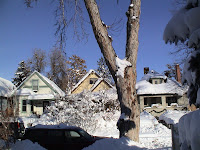
Avoiding the drudgery of listening to politicos pontificate at any public assemblage, David and I kept to the outskirts of the crowd where I took pics when I had a clear shot (the clear shots were available just for an instant
before someone walked in front of me). The Highland Bridge event and its significance is detailed
here. Suffice it to say, Saturday morning was sunny and crisp, an intermittent frigid breeze keeping us all awake...in spite of the politician's rhetoric. So, here are a few shots of the significant event in our little corner of the world.
 Councilwoman
Councilwoman Judy
Montero (District 9) began the dedication ceremony. Gotta say she reminded me of a high school cheerleader, admonishing the crowd that their "Good Morning," was not loud enough and that, "It's okay to be rowdy. We're rowdy in North Denver." Suffice it to say, Councilman Rick Garcia (District 1), whose district skirts
Montero's (and who really should have been visible for this significant occasion), didn't show up.

Denver's elected Auditor, Dennis Gallagher, did show up for the event. This larger-than-life character dressed typically for the occasion, probably quoting Shakespeare as he rose to take his bow.

Mayor
Hickenlooper and his son, Teddy, did show up for the event. (Is Teddy still in his
jammies?)

There was a mariachi group from Bryant-Webster Elementary school. They were wonderful. But, several shots of this young man on the violin (his expression never wavering) gave rise to the question if he was just angry about the whole shebang, scared to death or really, really having to pee and
can't we just get this damned thing over with!I'm glad David and I went. It was our little historic event for our little corner of the world. The festivities went on into the evening, culminating in a celebration of light across the bridge by the good folks from both the lower Platte Valley community and the Highland's neighbors on the other side.

















































